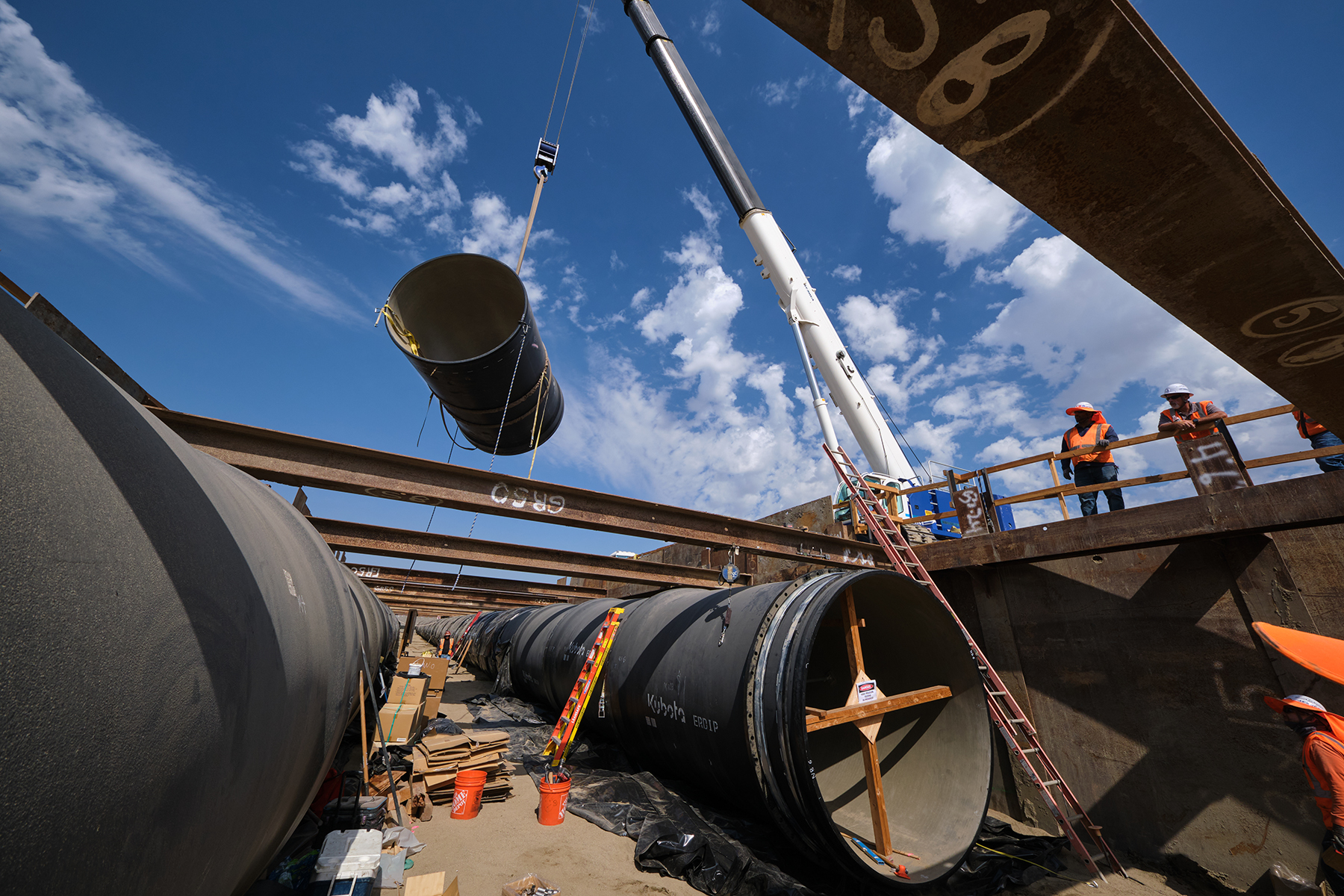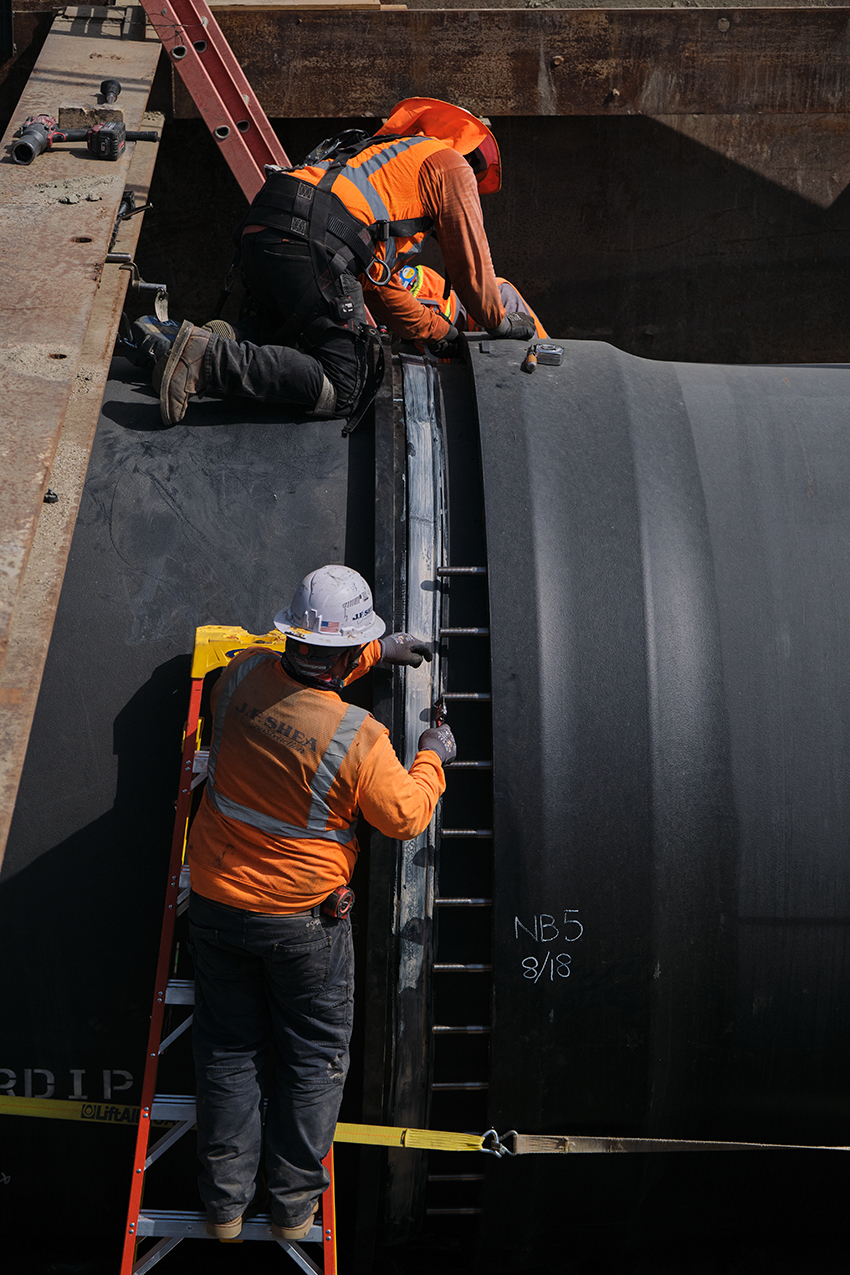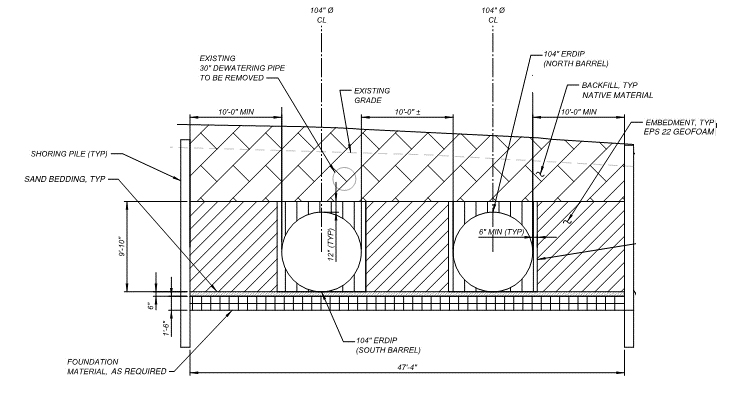By Robert L. Reid
In the San Jacinto Valley, southeast of Los Angeles, the twin threats of earthquakes and subsidence from groundwater pumping decades ago pose multiple challenges to the Metropolitan Water District of Southern California, which imports water from the Colorado River and Northern California to serve roughly 20 million people across a 5,200 sq mi area. To bring water into that region via the Colorado River Aqueduct, the water district maintains the Casa Loma Siphon, a 5 mi long underground pipe constructed along with the rest of the aqueduct in 1935.
Over the decades, however, the 148 in. diameter cast-in-place concrete siphon experienced considerable cracking in its rigid joints that led to water leakage because of ground movement where the structure crosses the Casa Loma Fault, notes John Bednarski, P.E., the water district’s chief engineer. Consequently, a 300 ft section of the siphon was replaced in 1968 with 148 in. steel pipe that featured external sleeve couplings designed to permit a small amount of movement.
But continued ground subsidence eventually caused leakage from the steel pipe section as well. Ongoing seismic assessments also indicated that the siphon faced a potential horizontal ground displacement of as much as 13 ft during a seismic event, and non-seismic groundsettlement had led to a vertical displacement of more than 5 ft over the past 84 years, according to a Dec. 14, 2021, report to the water district’s board of directors’ engineering and operations committee.
To make this section of the siphon that passes through the fault zone more resilient to seismic events and ground subsidence, the water district is replacing about a 1,200 ft long portion of the existing steel and concrete structure with a combination of roughly 600 ft of additional welded steel pipe and 600 ft of a special type of pipe known as earthquake-resistant ductile iron pipe, says Bednarski.

The new sections of welded steel pipe match the 148 in. diameter of the original siphon, but the ERDIP sections — manufactured in Japan by the Kubota Corp. — are available in a maximum diameter of 104 in., he adds. As a result, the ERDIP segment consists of two side-by-side pipes — known as barrels — connected to the new steel sections by steel Y-branch transition pieces.

The ERDIP segments allow up to 13 ft of horizontal movement during a seismic event. (Image courtesy of the Metropolitan Water District of Southern California)
It takes “two barrels of this ERDIP pipe running parallel to one another to get us the same capacity as the original, single-barrel pipe,” Bednarski explains.
The ERDIP sections vary in length from roughly 6.5 ft to nearly 13.3 ft, while the welded steel sections reach up to 20 ft long. The ductile iron joints connecting the ERDIP sections feature a gasket for water tightness and a lock ring to hold the joints in place.
The water district and its consultants worked with Kubota over the last several years to design the pipe and test it in the Kubota factory “to make sure that each of the joints is flexible enough to meet certain specified criteria,” Bednarski says. “So when you align all of these pieces of pipe together and each joint can move a certain amount, it will give us that 13 ft of movement in the horizontal direction it will need.”
To help accommodate ground displacements, the ERDIP segment is surrounded by a geofoam material, rather than compacted soil. The geofoam allows “the affected reach of the pipe within the primary fault zone to move by compressing the geofoam as it passively deforms/flexes in response to a seismic fault rupture event,” Bednarski says. The ERDIP segment is designed to withstand a seismic fault rupture event with a moment magnitude of up to 7.5, representing the maximum considered event, he adds.

The pipes were installed along an east-west alignment, about 10 ft below the surface. The route of the pipe is within the water district’s permanent easement, protected by fencing to ensure that heavy vehicles do not drive over it, Bednarski notes. Each joint was pressure-tested as it was installed to ensure there will be no leaks.
Located parallel to but about 50 ft from the original siphon, the $37 million ERDIP project is largely complete. But the new system will not go into operation until sometime in February during an annual maintenance shutdown of the aqueduct, Bednarski says. “That’s when they’ll install a physical connection to the aqueduct that allows the water to go through the earthquake-resistant pipe,” he explains.
The ERDIP project team was led by Carollo Engineers Inc., of Walnut Creek, California, and included San Francisco-based Degenkolb Engineers for structural engineering. Lettis Consultants International Inc., of Concord, California, and Hushmand Associates Inc., of Irvine, California, were the primary geotechnical and geological consultants. Concord-based JDH Corrosion Consultants Inc. provided corrosion consulting, and Ballantyne Consulting, of Seattle, provided general technical support. The general contractor was J.F. Shea Construction Inc., of Walnut, California.
This article first appeared in Civil Engineering Online.



